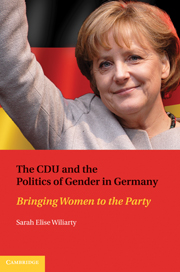Book contents
- Frontmatter
- Contents
- List of Figure and Tables
- Acknowledgments
- The CDU and the Politics of Gender in Germany
- Introduction: A Democratic Paradox?
- 1 The Puzzle of CDU Policy Making on Women's Issues
- 2 The Corporatist Catch-All Party Model
- 3 The Postwar CDU: Origins of a Corporatist Catch-All Party
- 4 The Emergence of the Women's Union, 1969–1982
- 5 The Women's Union in the Dominant Coalition, 1982–1989
- 6 Looking Eastward: The Women's Union and Cobbled Coalitions, 1989–1998
- 7 The Rise of Angela Merkel: Policy and Personnel Decisions of the CDU in Unified Germany
- 8 Christian Democracy With and Without Corporatism: Policy Making on Women's Issues in Austria, Italy, and the Netherlands
- 9 Conclusion
- Appendix: List of Cited Interviews
- List of References
- Index
7 - The Rise of Angela Merkel: Policy and Personnel Decisions of the CDU in Unified Germany
Published online by Cambridge University Press: 17 November 2010
- Frontmatter
- Contents
- List of Figure and Tables
- Acknowledgments
- The CDU and the Politics of Gender in Germany
- Introduction: A Democratic Paradox?
- 1 The Puzzle of CDU Policy Making on Women's Issues
- 2 The Corporatist Catch-All Party Model
- 3 The Postwar CDU: Origins of a Corporatist Catch-All Party
- 4 The Emergence of the Women's Union, 1969–1982
- 5 The Women's Union in the Dominant Coalition, 1982–1989
- 6 Looking Eastward: The Women's Union and Cobbled Coalitions, 1989–1998
- 7 The Rise of Angela Merkel: Policy and Personnel Decisions of the CDU in Unified Germany
- 8 Christian Democracy With and Without Corporatism: Policy Making on Women's Issues in Austria, Italy, and the Netherlands
- 9 Conclusion
- Appendix: List of Cited Interviews
- List of References
- Index
Summary
Thus far, this book has argued that the corporatist catch-all party structure shapes the CDU's approach to policy making. This chapter contends that internal party organization has also had an important effect on the selection of party leadership. A corporatist catch-all party demands a diverse leadership team. Because leadership positions within the party are inherently limited, any single person who can fill more than one internal minority slot will be highly desirable. This person's presence on the leadership team frees up another slot for a different member of the party elite.
Angela Merkel, the chair of the Christian Democratic Union (CDU), was elected Chancellor of Germany in 2005, the first woman to hold this position. The logic at work in the leadership selection process in a corporatist catch-all party can help explain the rise of Angela Merkel. At first glance Merkel, a female Protestant from the East, appears to be a poor match for the CDU, a party known for its roots in Catholic southern Germany and for its conservative ideology regarding women. Merkel's rise to power can only be understood by studying the internal party dynamics of the CDU and Merkel's leadership approach.
The CDU's corporatist catch-all party structure contributed to Merkel's initial rise to prominence. Because Merkel could be viewed as representing several internal party groups, she was a frequent choice when the CDU was selecting its leadership team. Once in office, however, Merkel proved to be a surprisingly competent politician.
- Type
- Chapter
- Information
- The CDU and the Politics of Gender in GermanyBringing Women to the Party, pp. 163 - 184Publisher: Cambridge University PressPrint publication year: 2010

